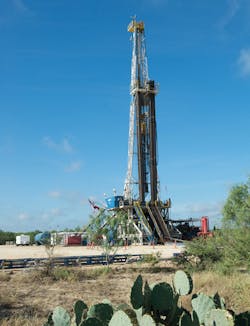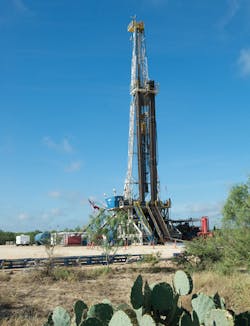Industry analysts provide insight into crucial oil and gas issues
Chesapeake Energy operations in the Eagle Ford Shale. Photo courtesy of Chesapeake Energy
Oil and gas research analysts lead a busy life. Not only do they keep up with the economic and financial position of various companies they cover, but they also keep up with macro-economics for the entire petroleum industry because this can impact individual company performance. Other analysts are specialists in specific industry segments, such as North American natural gas, onshore companies, offshore companies, oil majors, independents, oilfield services, etc.
For this article, Oil & Gas Financial Journal talked to a number of analysts and industry strategists engaged in research activity. Our purpose was to obtain a cross-section of opinions on a variety of topics critical to the petroleum sector, including shale development, the future of natural gas, fracturing and regulatory risk, the crude oil revolution in North America, joint ventures, technology, and geopolitical risk – to name a few.
So let's begin:
How important is shale to America's energy future? Is it a game-changer?
We think so. However, as you know, it's not just the shales. A lot of these oil plays aren't pure shales. They're sandy shales or silty shales or other types of rock that are embedded between shales. So it's really more resource plays, and horizontal development of those is going to continue as long as it's economic to do so. We think there are a lot of factors that go into that. A big driver for shale development going forward is going to be increasing the recovery factors in those plays because there is certainly a lot of oil and gas in place. We have just scratched the surface in most of these plays with well under sub-five and sub-ten recovery factors. And that's where we think a lot of incremental value is still to be had. – William Butler, E&P research analyst with Stephens
Is this true for the oilfield services sector as well?
If you look at the evolution of natural gas over the past 10 or 15 years, you used to be able to sustain or grow production with 1,200 to 1,400 rigs operating. Now the industry has discovered that you need far fewer rigs to grow production, and the industry is still kind of wrestling with the right equilibrium. The supply side has changed tremendously over the past few years. We're learning how to do more with less – fewer rigs running. But there are still a lot of factors to be discovered, the ultimate decline curves and the recovery factors, as William mentioned. But the technology that made all this possible started right here in the US, and I don't expect that to change. – Michael Marino, research analyst covering oilfield services for Stephens
Natural gas prices have been chronically depressed for some time now. How will the current low prices impact shale development projects?
There are three things that have led to the development of shale in North America: horizontal drilling, fracture stimulation, and commodity prices. It takes higher commodity prices to justify development of shale resources, so anything that softens prices will slow down shale development, whether it's oil or gas. We're certainly seeing that in natural gas today. The industry has done a very good job of developing infrastructure and bringing gas to market. We've actually seen North American production growth in natural gas, something we were concerned would never happen as recently as five or six years ago. We've been so successful that we now have an abundance of natural gas, and we're seeing a softening of gas prices, which has translated into a slowing of drilling activity. The rig count is down from about 800 a year ago to about 565 rigs drilling for natural gas today. At some point, you'll see a supply response, and supply and demand will come back into greater balance, and with that a firming up of gas prices, which would then spur more development. My gut feeling is that natural gas prices probably need to be in the $4 to $5 range to justify development of a lot of the shale gas plays. Until we get back to that level, I think we'll see the gas rig count continue to decline. – James R. McBride, head of investment banking for Capital One Southcoast
In your view, what will happen to the natural gas industry in the US if prices stay around the current level for the next two to three years?
A prolonged period of low natural gas prices, to no surprise, likely leads to E&P consolidation: There are a number of small-cap, gas-weighted E&Ps that are late in the transition to oil and liquids plays. If they encounter operational difficulties or financing difficulties a merger or sale may be the best alternation. As small companies, they often lack sufficient technical staff to devote to the new crude and liquids plays and on the funding side they are usually slated to outspend cash flow. More data on this trend should become available as we begin the June 30 period redetermination of bank borrowing bases. – John White, vice president and research analyst, Triple Double Advisors
What will happen in the natural gas industry if gas prices don't recover? Will there be a massive shakeup?
I don't see a scenario where gas stays at this level. If you look at EIA data from the past two months, natural gas production is declining. The reason it's declining is because drilling activity has declined. Drilling didn't start to decline until prices got below the $4 level. Since then drilling for natural gas has continued to decline. If you stop drilling these shale wells that have initial decline rates in the 60% to 70% range, you're removing a lot of production from the market. So we are seeing and will continue to see a supply-side response to these low prices. So unless we start to see a significant reduction in demand, I can't see gas prices remaining low for an extended period of time. – James R. McBride, Capital One Southcoast
In its annual benchmark study released in June, Ernst & Young says that 2011 was a banner year for drilling. Can you elaborate?
The US oil and gas industry had a banner year for growth across several categories. Combined exploration and development spending increased 38% in 2011. Oil reserves grew by 9%, or 1.7 billion barrels, while oil production increased 3%. In spite of low prices, gas reserves and production rose 4% and 9%, respectively in 2011. However, in my view, we'll be hard-pressed to see another year of growth in natural gas reserves. Oil and gas revenues experienced 23% growth last year. The combination of strong prices for oil and ever-improving technology has turned the US into a growth market. The tremendous success of oil production in the Bakken formation, for example, is a true testament to the domestic opportunity and the industry's ability to act on that opportunity. – Marcela Donadio, Americas oil and gas sector leader for Ernst & Young
That is pretty impressive considering that the US is emerging from an economic recession very slowly.
It's really a renaissance of the US as an oil province. As far as oil is concerned, the US has been in a production decline for more than 20 years. This resurgence is due to technological improvements and the use of sophisticated multi-stage fracturing completion techniques in combination with horizontal drilling to access oil reserves in unconventional resource plays such as the Bakken in North Dakota and the Eagle Ford in South Texas. If natural gas prices get back into alignment, this industry segment will also see improvement. There are indications that concerns about low natural gas prices may be short-lived. It's crucial to increase demand and get natural gas back into the broader economy. But until that happens, finding and producing crude will be much more cost effective than finding and producing natural gas. – Charles Swanson, managing partner, Ernst & Young, Houston
We hear a lot about environmental concerns related to hydraulic fracturing and other drilling and completion techniques. Without this technology, oil and gas production from shale would not be economic. Do you see this as a significant risk to the development of unconventional resource plays?
Yes, I think the political risk is real. However, it is a misperception. There is no real danger that hydraulic fracturing fluids will leak into the water table. Still, there is a general public consensus that there is a danger and the political environment is unpredictable. Having said that, I think that rationality usually prevails over time in Washington and they will come to the right conclusion, which is, if you properly case the upper part of the well, there is very danger to the water table. The industry takes these environmental risks very, very seriously. – William Butler, Stephens
Do you think we'll see more M&A activity in the oilfield services sector?
It's always so hard to predict, but I do think we're going to see a lot more activity on the private company side. We've had more private equity money in this sector in recent years, and some of the smaller service companies have been struggling with labor issues, supply chain management, reduced rig count, and so forth. If they are confined to one basin and that basin is primarily a gas basin, they are really struggling. The current market doesn't favor someone who's operating in one basin or has a single product offering. If you're a little guy, it's hard to compete in that kind of landscape. Take Halliburton, for instance. They have a huge competitive advantage in areas like the Bakken or the Eagle Ford where they basically have built whole neighborhoods to accommodate workers. Contrast this with XYZ Well Service Company that is trying to recruit people from Texas and fly them up to North Dakota on a charter flight, put them up in a hotel if they can find a vacancy, and then fly them home. It's tough for them. I think a lot of them are going to cry "uncle" and maybe sell out to middle-level companies like a small mid-cap. Among onshore companies, I think the mid-cap companies are going to be acquiring small companies whose names we may not know. Right now there is a valuation disconnect between the private and the public market, and I think you're going to see more of these small private companies succumb to market pressures. So that will drive some M&A. – Michael Marino, Stephens
Crude oil prices have been declining lately and are now in the $80 to $85 range in the US. At what point do lower oil prices affect shale development? What is the break-even point?
It's well below the $80 level and probably in the $50 to $60 range for the Bakken and the Eagle Ford, which are the major oily shale plays. The lower prices are a sign the market is correcting due to the huge disparity that existed between natural gas and oil prices. Gas prices needed to go up or oil prices needed to come down. In the longer term, I think we'll see oil prices moderate somewhere in the $70 to $80 range, and companies can still make good money at that level. – James R. McBride
Who is the most exposed to regulatory risk, and who has the most to lose if we get new federal or state rules governing hydraulic fracturing?
The American people have the most to lose because keeping energy prices low is critical to any economic recovery. – James R. McBride
With respect to M&A activity, is there still room for another major corporate acquisition on the scale of the ExxonMobil-XTO Energy deal?
The majors are continuing to build a larger presence in North America because it is an attractive place to be right now. I wouldn't rule out another large corporate deal. – James R. McBride
The New York Times ran a story recently that said the power generation industry and electric utilities feel threatened by low natural gas prices. Why do they consider natural gas a threat? Isn't a clean-burning, low-priced fuel a good choice for power generation?
It's not necessarily the industry as a whole but more the utilities that have relied more heavily on coal because that's obviously a pressure against coal generation. The big concern that many utilities still have is that despite the abundance of natural gas and, at the moment, relatively low and stable prices, the memories of the past decade have not gone away. The potential for volatility and high prices scares a lot of folks. I don't think the power industry truly grasps the true dimension of shale gas, how abundant it is. They're still looking at gas from a historical perspective, and they are hesitant to make the switch from coal to natural gas. Just a quick bit of power market history: In the early 2000s, there was a huge boom of building gas-fired capacity. After that, natural gas prices ramped up quite quickly, which made those units pretty uneconomic. As a result, a number of these merchant generators actually went bankrupt in that period. So that is part of the reluctance. That history had a profound impact on the industry. – Brett D. Blankenship, senior research analyst, Wood Mackenzie
Hasn't coal's share of the power generation portfolio been eroded over the years by natural gas and by alternative energy forms, such as wind generation?
Yes. In general the mix has become more diversified and this will continue going forward. Gas will continue to take away market share from coal, and renewables will start to take hold even more as states mandate that they become an increasing part of their generation portfolio. By 2030, coal generation is expected to drop to 25% of total US generation. That's a far cry from its peak of nearly 57% in the late 1980s. – Brett Blankenship
Is part of the reluctance to switch from coal to gas a geographic issue? Aren't some of the traditional coal-producing states like West Virginia putting up the major roadblocks to switching?
The local economies play a big part in this. When you look at states like West Virginia and Kentucky that have traditionally relied on coal, they don't want to move away from coal because less coal production would have a direct impact on their local economies. Coal is really ingrained with the economy and the culture in some of those states just as oil is in Texas. – Brett Blankenship
What can be done to help the natural gas industry going forward – for example, encouraging more commercial truck fleets to switch from diesel to natural gas, private cars making the switch as Boone Pickens recommends, more gas-fired power generation, etc.?
Most discussions of what to do with our new supplies of natural gas are focused on natural gas as a commercial truck and passenger transportation fuel. We agree there is significant potential in those areas. What we notice is not discussed as often is the potential for gas-to-liquids or GTL.
As most of your readers know, GTL is a process that converts natural gas into a middle distillate very similar to diesel fuel. By using this type of fuel, some in the industry believe it will make the conversions of car and truck engines and retail gasoline outlets less expensive and easier.
In 2011, Royal Dutch Shell plc announced the first shipment from its flagship Pearl GTL plant in Qatar. This $18 billion plant, built in collaboration with state-run Qatar Petroleum was a major milestone for the GTL business. Peak production is expected on the order of 250,000 barrels per day, with about 150,000 of that being diesel. Shell is considering building a huge gas to liquids (GTL) plant in Louisiana, which may be comparable to the size of its Pearl Qatar GTL plant. Initial reports are that the Louisiana plant would cost in excess of $10 billion. Also, South Africa-based Sasol has announced plans to build a GTL plant in Louisiana, again at a cost of up to $10 billion that would convert natural gas into diesel fuel for trucks and other vehicles. Sasol is a longtime participant in the GTL industry, having operated plants in South Africa for years. Sasol also joined with Qatar Petroleum to open the 34,000 barrel per day Oryx GTL plant in 2006. In addition to opening new markets for natural gas, these plants have an employment, and hence political, appeal: they employ tens of thousands of construction worker during the build out phases. – John White
More Oil & Gas Financial Journal Archives Issue Articles
View Oil and Gas Articles on PennEnergy.com







